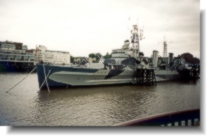Naval Bombardment
After three days on board we left the harbor to rendezvous with many other ships. It is no wonder that having been on the ship for only three days I was not as well trained as the others that participated in the invasion. The weather was so fierce with strong winds and heavy rains that the invasion was delayed for one day. In the night prior to June 6th we proceeded to cross the English Channel. The Captain announced to the crew over the PA system " Attention all hands, you are about to take part in the greatest invasion in history, the invasion of Normandy". The seas remained rough for the crossing. Just at daybreak I heard a really loud noise above us. It was hundreds of C47's each towing a glider. All these planes were together darkening the skies. Shortly after that all hell broke loose when the bombardment commenced of the beach and gun emplacements. We had the element of surprise for awhile but then they retaliated with heavy gunfire. We were constantly on our battlestations. Food was brought to us and we were only permitted ten minutes bathroom leaves. The noise was deafening. Bombs kept landing beside our ships. The bombardment started to soften up the defenses so the troops could land safer. We were no part of the landing party so we gever got close to the beach. We fired non-stop and when we had run out of fuel and ammunition we returned to Plymouth, to refuel and come back and continue the bombardment. We kept the going back and forward to Plymouth up for two weeks. Read the full story here.
Jack Mills: We also watched that duel between a Destroyer and an 88 MM gun on land. The 88 was walking his shots out toward the Destroyer and had there been a next one it would have hit the ship but it never came and we assumed that the ship got him. I think that the Navy really saved the day with their shelling of the beaches. |

 Bill Rugh
Bill Rugh